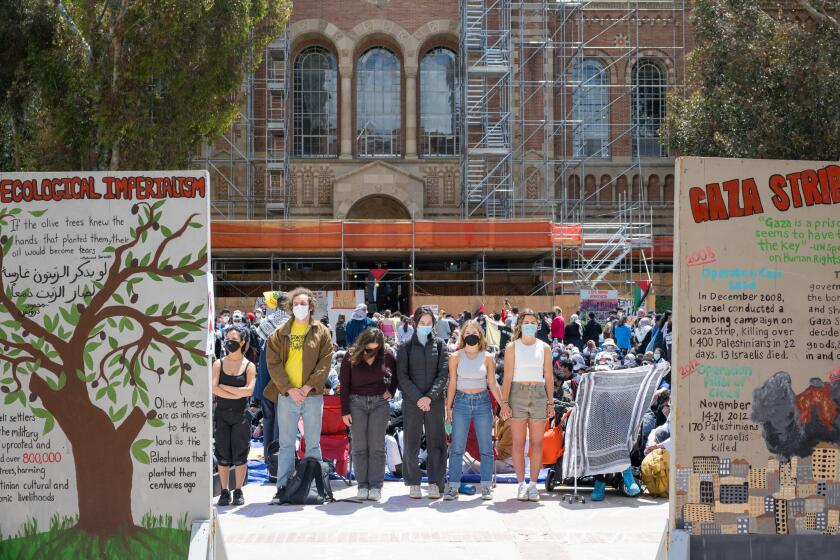Op-Ed: How Boyle Heights, on L.A.’s Eastside, became a model for grass-roots American democracy

Fourteen-year-old Mollie Wilson was furious that her four best friends were being taken away from her just before they were scheduled to start high school together in 1942. The precocious African American teenager had just heard that the U.S. government had decided to send her Japanese American classmates, along with their families, to incarceration camps in the interior of the country and away from their Boyle Heights neighborhood. Mollie vowed to write each of them every week they were away as her own form of protest against this unfair decision.
The letters she received back are now in the hands of the Japanese American National Museum. They’re historically significant for their descriptions of the wartime incarceration — but also because they attest to the profound cross-racial friendships that were common in the Boyle Heights community of Los Angeles’ Eastside throughout most of the 20th century.
Unlike most of the rest of Los Angeles, Boyle Heights did not maintain racially restrictive covenants but was open to anyone willing to work hard at nearby factories or businesses fueling the industrial growth of the region. If you were a working-class newcomer to the city in the first half of the 20th century, chances are you lived in or spent spent significant time in Boyle Heights, just across the river from downtown L.A.
Mollie lived on Boulder Street, on a block with families from 10 different ethnic backgrounds, all living harmoniously together.
“My mother learned to cook from Jewish people because she had not been taught by her own mother,” Mollie later remembered. “It often amazed me how my mother could communicate with Mrs. Koris or Mrs. Akashi, because neither of them could speak English and my mother couldn’t speak Greek nor Japanese.”
This unique history, and the friendships and coalitions it generated, makes Boyle Heights a model for the kind of grass-roots democracy and cross-cultural cooperation needed today to heal a divided nation and to combat inequality. While newcomers from Mexico, Eastern Europe, Japan, Italy and the American South all made Boyle Heights home, their different languages and backgrounds had to be overcome if they were to fight side by side for survival in a neighborhood of working-class families at a time when elite Anglo Americans ran all of Southern California.
The challenges they faced were many. They lost jobs during the economic collapse of the Great Depression. Mexican immigrant and Mexican American families were targeted for deportation and repatriation back to Mexico. Japanese Americans were incarcerated in camps during World War II. Jews faced antisemitism, including from Nazi agents and sympathizers in Los Angeles itself. Over the two decades after the war, the community was transformed by public housing projects that replaced single-family homes and rental units and was divided by five freeways that took up 15% of the land — including the Golden State Freeway, which was built right up against the edge of Hollenbeck Park.
Yet this widespread targeting of the Boyle Heights population was met with stoic resistance and impassioned counter-organizing. Jewish immigrants — who made up about 40% of Boyle Heights in the 1920s and 1930s — brought with them an East Coast labor-organizing tradition and a radicalism from Eastern Europe that led Los Angeles-based trade unions to set up shop in Boyle Heights, where they organized Mexicans and Italians as well as Jews. The International Ladies Garment Workers Union spearheaded cross-racial efforts among Mexican and Jewish women to fight for higher wages in the 1930s. Those were followed by organizing drives for improved conditions by unions of cannery workers and carpenters.
After World War II, the Community Service Organization was created by grass-roots activists in the Mexican American and Jewish communities to fight discrimination in housing, schools and employment. In 1949, the CSO helped elect Los Angeles City Councilman Edward Roybal, the first Mexican American to sit on the council since the 19th century. Roybal fought to bring basic services to the Eastside, as well as to combat police abuse of residents and fight against efforts at urban renewal that did not consider the needs of Boyle Heights locals. Even as the Jewish community increasingly moved away from Boyle Heights in the 1940s and 1950s, the Soto-Michigan Jewish Community Center — located on the corner of Soto Street and Michigan Avenue — became a site of innovative multiracial programs, some of the first ever institutionally in Los Angeles.
This tradition of activism continued in the 1960s, when local students organized the 1968 Chicano walkouts from high schools to protest educational inequities, demand the hiring of Mexican American teachers and encourage the implementation of culturally relevant college preparatory education.
As the demographics began to change again, this time with more undocumented residents coming to live in the neighborhood in the latter half of the 20th century, new organizations were created to incorporate them. Mothers of East Los Angeles organized women and men from Catholic parishes to fight state efforts to place prisons and environmentally hazardous factories in or near Boyle Heights. Homeboy Industries was formed by Father Gregory Boyle to present alternative ways of life to gang-affiliated young people from the neighborhood.
Today, as Boyle Heights (like other urban neighborhoods in L.A.) struggles with gentrification pressures, it has a rich and diverse history of local organizing and community engagement to draw upon. As the United States more broadly becomes a majority-minority country over the next 25 or so years, it needs to look to solutions at the neighborhood level that places like Boyle Heights can proudly speak to.
George Sánchez, a history professor at USC, is the author of “Boyle Heights: How a Los Angeles Neighborhood Became the Future of American Democracy.”
More to Read
A cure for the common opinion
Get thought-provoking perspectives with our weekly newsletter.
You may occasionally receive promotional content from the Los Angeles Times.






